|
HMS Zubian
F or Tribal-class destroyer, 1,050t (tons),
"completed" July 1917 by Chatham Dockyard, approximately 280ft long, speed
34kts (knots), armed with two 4in guns and two single 18in tt (torpedo
tubes).
Sister ship HMS Nubian was
damaged by torpedo 27 October 1916, the stern survived. HMS Zulu was mined
and disabled on 8 November 1916, in this case the bow survived. The two
halves were joined between the 3rd and 4th funnels, and HMS Zubian was born.
Whoever said the British Admiralty does not have a sense of humour?
The 12 Tribal-class vessels (Zubian
was the 13th) served as the 6th Destroyer Flotilla at Dover for most of the
war. Two more were lost in addition to Nubian and Zulu.
|
|

1. Starboard side |
| |
|
|
|
 Perhaps quite a rare connection - the name and
photograph of a Dockyard worker linked to a World War 1 ship he worked on.
In this case, the building of HMS Zubian from the two Tribal-class halves.
Arthur Thomas Mudge, 1878-1952, worked all his life as a Blacksmith in
Chatham Dockyard, including World War 2, and died aged 74. Described as a
kind man, who never married, he also had a "smithy" at his Uncle
John Mudge's farm in Gillingham, Kent,
where he would repair equipment and shoe the horses. (With thanks to Ann
Booker (24
Sep 2012). Arthur was her Grandmother's cousin.) Perhaps quite a rare connection - the name and
photograph of a Dockyard worker linked to a World War 1 ship he worked on.
In this case, the building of HMS Zubian from the two Tribal-class halves.
Arthur Thomas Mudge, 1878-1952, worked all his life as a Blacksmith in
Chatham Dockyard, including World War 2, and died aged 74. Described as a
kind man, who never married, he also had a "smithy" at his Uncle
John Mudge's farm in Gillingham, Kent,
where he would repair equipment and shoe the horses. (With thanks to Ann
Booker (24
Sep 2012). Arthur was her Grandmother's cousin.) |
|

2.
White Ensign and French ensign flying on mainmast |
| |
|
|
 |
|
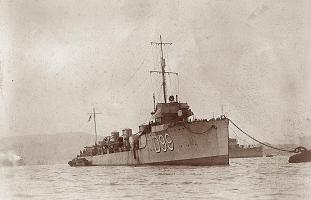
3. and 4. At anchor |
| |
|
|

5. Forecastle, looking aft past forward 4in gun |
|

6. Quarterdeck, looking astern. Note single depth charge |
| |
|
|

7. Underway, starboard side from bridge |
|

8. Moored, starboard side looking
forward |
| |
|
|
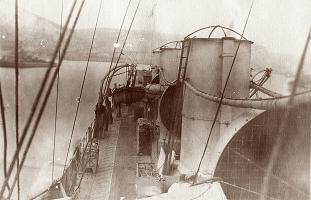
Patrol boat in background
9 and 10. Moored in Dover Harbour |
|

Naval drifters and paddle minesweepers in background |
| |
|
|

11. Going alongside an apparent merchant
vessel in Dover; Sub Lieutenant RN in charge. Name on side of vessel could be
British and/or Georgiana. No British Georgia or Georgiana identified. Might be
SS Georgiana, cargo ship, 4,523grt |
|

12. Wheelhouse, probably Coxswain at the wheel |
| |
|
|
| |
|
|
|
Her Officers |
| |
|
|
As the photographs were
probably taken between March and December 1918, this narrows down the
identification of the officers. Numbers in brackets are to help identification.
|
| |
|
|
|
November 1917 Navy List
Lieutenant in Command Henry J. Hartnott, assigned
20 June 1917 (1)
Lieutenant, RNR, William Campbell (Acting), assigned 18 June 1917 (2)
Acting S/Lt, RNR Thomas N. Heap (Acting), assigned 20 June 1917 (3)
Chief Artificer Engineer Francis S. Curtis, assigned May 1917 (4)
Gunner (T) Arthur Eves (Acting), assigned 17 September 1917 (5) |
|
December 1918
Navy List
Lieutenant in Command Gordon F. Hannay, assigned 30 May 1918
(6)
S/Lt William A.H. Harrison, assigned 1 November 1917 (7)
S/Lt John P. Apps, assigned 6 August 1918 (8)
Surgeon S/Lt, RNVR Beresford T. Richards, assigned 25 March 1918 (9)
Chief Artificer Engineer (4) and Gunner (T) (5) as 1917 List |
| |
|
|
| |
|
|
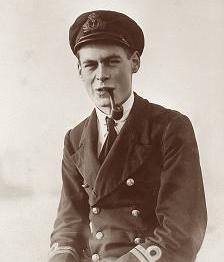
13. Lieutenant RN, probably one of two commanding officers - Henry Hartnott from
June 1917 or Gordon Hannay from May 1918. Believed the latter. |
|

14. From Image 22, Sub-Lieutenant RN, but may not be included in 1918 Navy List |
| |
|
|

15. Believed to be Chief Artificer Engineer Curtis |
|
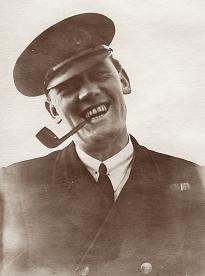
16. Not identified |
| |
|
|

17. Lieutenant, Royal Naval Reserve, only William Campbell is included in Navy
Lists |
|

18. Believed to be Chief Artificer Engineer Curtis and another Lieutenant,
Royal Naval Reserve |
| |
|
|

19. Sub-Lieutenant RN (possibly 7 or 8), Gunner (T) Eves (5), Chief Artificer
Engineer Curtis (4)
|
|

20. Chief
Artificer Engineer Curtis (4), believed
Lieutenant in Command Gordon F. Hannay, Gunner (T) Eves (5),
Sub-Lieutenant RN believed to be officer in No.14, |
| |
|
|

21. Having a drink in the Wardroom - Two
Sub-Lieutenants RN (possibly 7 and 8), Surgeon Sub-Lieutenant Richards, aged 24
or 25, (9), believed to be officer in No.14, probably Gunner (T) Eves (5) |
|

22. Unoccupied wardroom, reference
is made to it being the sick bay |
| |
|
|

23. Wardroom possibly earlier in 1918 - officer "at ease" (see 24), possibly
Captain's wife and earlier Lieutenant in
Command Henry Hartnott, fourth person not known
|
|
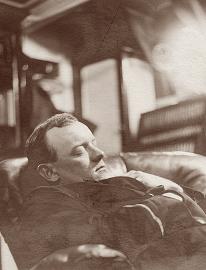
24. "At ease" - possibly
Sub-Lieutenant RN |
| |
|
|

25. Wife and daughters, possibly of Lieutenant in Command Henry Hartnott |
| |
|
|
| |
|
|
|
Torpedo
Firing, Recovery and Maintenance |
| |
|
|

26. 18 inch torpedo being fired |
|

27. Recovery by 27ft whaler. Note torpedo floating vertically at end of
run |
| |
|
|

28. Torpedo under tow |
|

29. (to 32.) Being hoisted on board; Gunner (T) Eves in charge |
| |
|
|

30. |
|

31. Note dent in practise warhead |
| |
|
|

32. |
|

33. Removing the practise warhead |
| |
|
|
 |
|
 |
| 34. Looks like
three Petty Officer by the aft torpedo tube. Behind is a bandstand believed to
mount a 2pdr AA pom-pom gun |
|
35. .... and
again |
| |
|
|
| |
|
|
|
Dover Patrol Destroyers |
| |
|
|
Other Tribal-class vessels of the 6th
Destroyer Flotilla
all launched 1907-09, characteristics similar to HMS Zubian, although
differing in appearance |
| |
|
|

36. HMS Amazon |
|

37. HMS Viking |
| |
|
|

38. HMS Crusader |
|

39. HMS Crusader |
| |
|
|
| |
|
|
| right - A famous Flotilla
Leader. With HMS Swift, sank German destroyers G85 and G42 in the Battle of the
Dover Straits, the night of 20/21 April 1917. During the action Broke rammed G42
leading to hand-to-hand fighting by the crews. Commander Evans of the Broke was
subsequently renowned as "Evans of the Broke" |
|

40.
HMS Broke, Faulknor-class, 1,610t, launched May 1914, 31kts,
6-4in/4-21in tt |
| |
|
|
|
M-class, c1,000t, launched July-December
1914, 34kts, 3-4in/4-21in tt, appearance depended on builder |
| |
|
|

41. HMS Mastiff, Thornycroft-built with
three funnels |
|

42. HMS Mastiff |
|
|
|
|
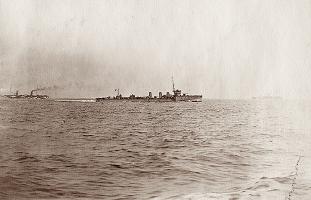
43. HMS Moorsom, John Brown-built, also
three-funnelled |
|

44. HMS Moorsom |
|
|
|
|
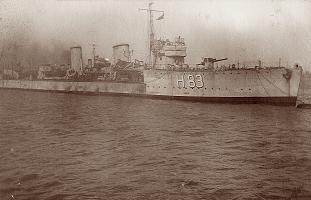
45. HMS MIranda, Yarrow-built with two funnels |
|

46. HMS Myngs, Palmer-built |
|
|
|
|

47. HMS Mentor, Hawthorn-built with four funnels;
believed to be transport Ville de Liege in background |
|

48. Minesweeping paravanes on the stern,
probably of
an unidentified destroyer laying alongside.
Note gun breech on left |
|
|
|
|
|
Talisman-class,
HMS Trident, 1,098t, launched 15 July 1915, 32kts, 5-4in/4-21in tt |
| |
|
|

49. and 50. both HMS Trident
|
|
 |
| |
|
|
|
Repeat M-class,
c1,000t, launched 1915-16, c34kts, 3-4in/4-21in tt |
| |
|
|

51. HMS Phoebe |
| |
|
|
| |
|
|
|
Other Dover Patrol Naval Vessels
and Escorts |
| |
|
|

52. Believed to be Dover Harbour Board tug and
ex-cruiser HMS Vindictive. She returned to Dover after the Zeebrugge Raid on 23
April 1918 and was patched up before being expended at Ostend on the 9 May.
Photograph must have been taken in early May |
|

53. Lord Clive-class 12in monitor, possibly General Crauford or Sir
John Moore |
| |
|
|

54. HMS Glatton (above - Photo
Ships), monitor, ex-Norwegian coast defence battleship, 5,700t, commissioned 31
August 1918. Magazine exploded and caught fire on 16 September. Scuttled by
torpedoes. |
|

55. Wreck of HMS Glatton in Dover harbour |
| |
|
|

56. (to 58) P-type patrol craft, 610t, launched
1915-18, 20kts, 1-4in/2-14in tt. Above and right - HM P.21, launched March
1916, moored at Dover |
|

57. HM P21 |
| |
|
|

58. HM P.48, launched September 1917 |
|

59. US Elco-built Motor Launch ML.588 entering port |
| |
|
|

60. Armed trawlers at their moorings inside Dover mole, apparently raising steam |
|

61. HMS Zubian presumably passed one of them as she departed Dover
herself |
| |
|
|

62. One crew member with HMS Victory cap tally,
annotation appears to read "Trawler, (possibly) W H Pond?". Believed to be HM
Minesweeping Trawler W H Podd, Milford Haven-registered M.1, 225grt, built 1914,
Admiralty No. 154, armed with 1-6pdr AA gun |
|

63. US Elco-built motor launches with their
depot ship, HMS Arrogant. She was an ex-Arrogant-class 2nd class
cruiser, 5,750t, launched in 1896, and sister ship to HMS Vindictive
expended in the second Ostend Raid |
| |
|
|

64. Short 184 seaplane in Dover. P-type patrol
craft in background. |
| |
|
|

65. SS or Submarine Scout non-rigid airship flown
by the Royal Naval Air Service for convoy escort and anti-submarine patrol. In
this case SSZ.30. |
|

66. Another image of the same SSZ.30,
referred to in this case as a "Gas bag" |
| |
|
|
| |
|
|
Merchant Navy Vessels
mostly in dazzle camouflage |
| |
|
|
| Troop Transports |
| |
|
|

67. Unidentified troop transport in Dover, with troops onboard |
|

68. Could be cross-Channel steamer SS Victoria
which was also employed as troop transport, but there are differences
from other photographs. Annotation suggests SS Vafer or Nafer, but no
such vessel identifed; might also read Victoria |
| |
|
|
 |
|
 |
|
69 and 70. Believed to be passenger paddle steamer
P/S Princesse Clementine, 1,474grt, built 1897, owned by Belgian Government |
| |
|
|

71. Cross-Channel passenger ship SS Ville de Liege,
1,366grt, built 1913, owned by Belgian Government |
|

72. SS Princess Elizabeth, also owned by Belgian Government |
| |
|
|
| |
|
|
| Other Vessels |
| |
|
|

73. Tug Scott and believed to be British merchant
ship SS Manora, 7.875grt, built 1913 |
|

74.
Cargo ship |
| |
|
|
| |
|
|

75. Cargo ship. Note defensive gun on stern |
|
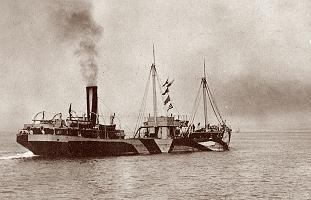
76.
Coastal collier |
| |
|
|

77. Dover Harbour Board tug in Dover Harbour,
believed Lady Crundall |
|

78.
Sunken brig - one of hundreds of ship casualties around the British
Isles in World War 1 |
| |
|
|